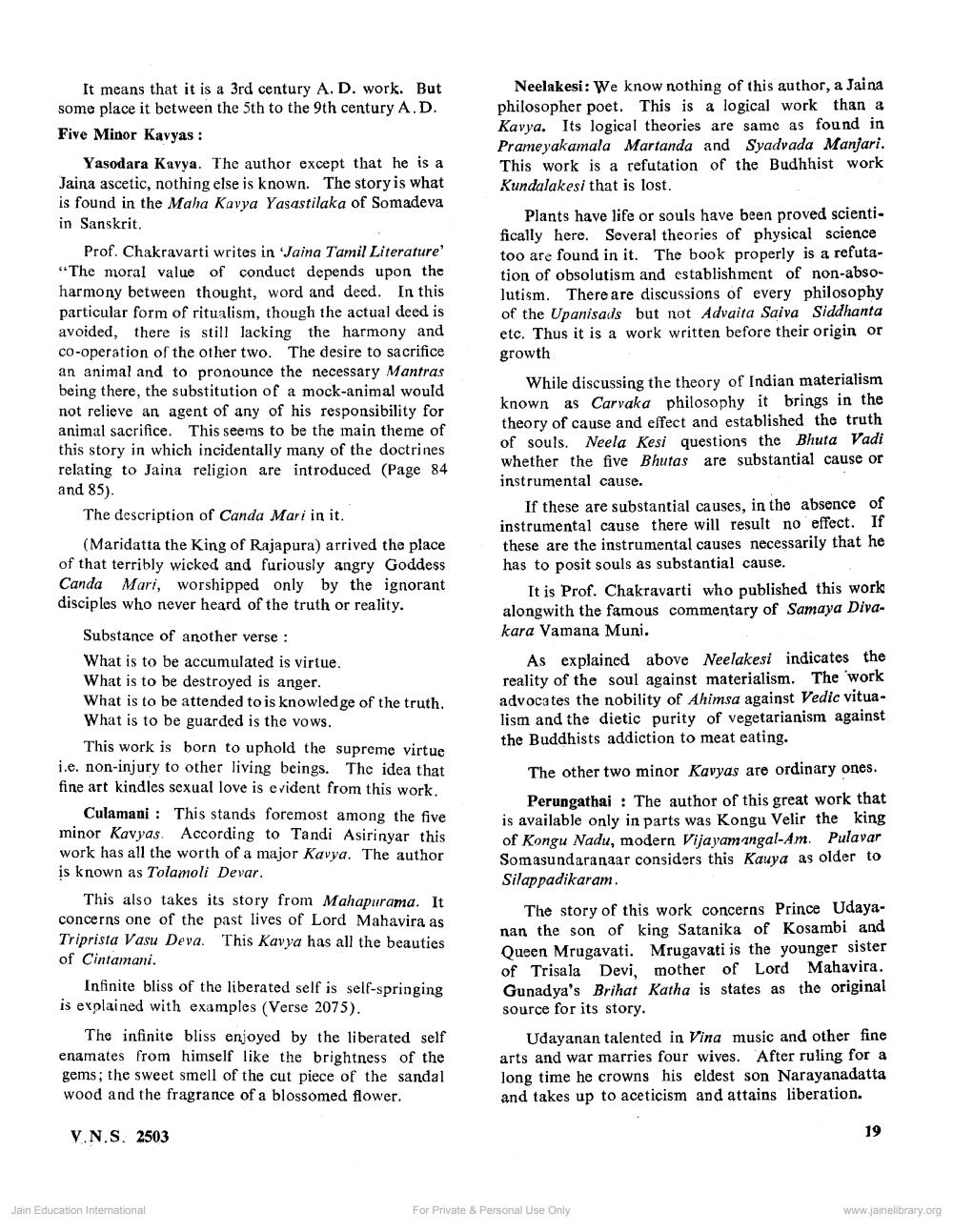Book Title: Jainism in Tamilnadu Author(s): S Gajpathi Publisher: Z_Rajendrasuri_Janma_Sardh_Shatabdi_Granth_012039.pdf View full book textPage 8
________________ It means that it is a 3rd century A. D. work. But some place it between the 5th to the 9th century A.D. Five Minor Kavyas : Yasodara Kavya. The author except that he is a Jaina ascetic, nothing else is known. The story is what is found in the Maha Kavya Yasastilaka of Somadeva in Sanskrit. Prof. Chakravarti writes in Jaina Tamil Literature' "The moral value of conduct depends upon the harmony between thought, word and deed. In this particular form of ritualism, though the actual deed is avoided, there is still lacking the harmony and co-operation of the other two. The desire to sacrifice an animal and to pronounce the necessary Mantras being there, the substitution of a mock-animal would not relieve an agent of any of his responsibility for animal sacrifice. This seems to be the main theme of this story in which incidentally many of the doctrines relating to Jaina religion are introduced (Page 84 and 85). The description of Canda Mari in it. (Maridatta the King of Rajapura) arrived the place of that terribly wicked and furiously angry Goddess Canda Mari, worshipped only by the ignorant disciples who never heard of the truth or reality. Neelakesi: We know nothing of this author, a Jaina philosopher poet. This is a logical work than a Kavya. Its logical theories are same as found in Prame yakamala Martanda and Syadvada Manjari. This work is a refutation of the Budhhist work Kundalakesi that is lost. Plants have life or souls have been proved scientifically here. Several theories of physical science too are found in it. The book properly is a refutation of obsolutism and establishment of non-absolutism. There are discussions of every philosophy of the Upanisads but not Advaita Saiva Siddhanta etc. Thus it is a work written before their origin or growth While discussing the theory of Indian materialism known as Carvaka philosophy it brings in the theory of cause and effect and established the truth of souls. Neela Kesi questions the Bhuta Vadi whether the five Bhutas are substantial cause or instrumental cause. If these are substantial causes, in the absence of instrumental cause there will result no effect. If these are the instrumental causes necessarily that he has to posit souls as substantial cause. It is Prof. Chakravarti who published this work along with the famous commentary of Samaya Divakara Vamana Muni. As explained above Neelakesi indicates the reality of the soul against materialism. The 'work advocates the nobility of Ahimsa against Vedic vitualism and the dietic purity of vegetarianism against the Buddhists addiction to meat eating. The other two minor Kavyas are ordinary ones. Perungathai : The author of this great work that is available only in parts was Kongu Velir the king of Kongu Nadu, modern Vijayamangal-Am. Pulavar Somasundaranaar considers this Kauya as older to Silappadikaram. The story of this work concerns Prince Udayanan the son of king Satanika of Kosambi and Queen Mrugavati. Mrugavati is the younger sister of Trisala Devi, mother of Lord Mahavira. Gunadya's Brihat Katha is states as the original source for its story. Udayanan talented in Vina music and other fine arts and war marries four wives. After ruling for a long time he crowns his eldest son Narayanadatta and takes up to aceticism and attains liberation. Substance of another verse : What is to be accumulated is virtue. What is to be destroyed is anger. What is to be attended to is knowledge of the truth. What is to be guarded is the vows. This work is born to uphold the supreme virtue i.e. non-injury to other living beings. The idea that fine art kindles sexual love is evident from this work. Culamani : This stands foremost among the five minor Kavyas According to Tandi Asirinyar this work has all the worth of a major Kavya. The author is known as Tolamoli Devar. This also takes its story from Mahapurama. It concerns one of the past lives of Lord Mahavira as Triprista Vasu Deva. This Kavya has all the beauties of Cintamani. Infinite bliss of the liberated self is self-springing is explained with examples (Verse 2075). The infinite bliss enjoyed by the liberated self enamates from himself like the brightness of the gems; the sweet smell of the cut piece of the sandal wood and the fragrance of a blossomed flower. 19 V.N.S. 2503 Jain Education Intemational For Private & Personal Use Only www.jainelibrary.orgPage Navigation
1 ... 6 7 8 9 10 11 12
